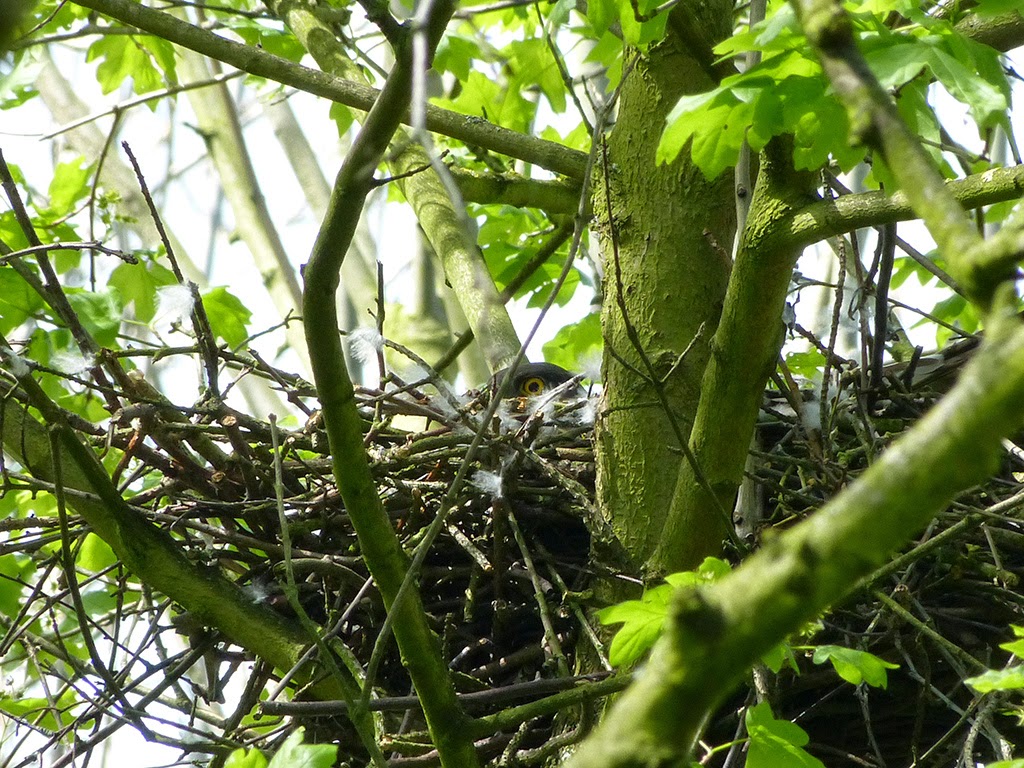The Sparrowhawk
was @SpeciesofUK from 10th to 16th March, 2014.
The UK's sparrowhawk is also known the 'northern
sparrowhawk' or 'Eurasian sparrowhawk' to distinguish it from other
sparrowhawks.[1]
 |
| Sparrowhawk [Flickr Creative Commons © Philippe Garcelon] |
It is a small raptor with short rounded wings and
long legs.
The sparrowhawk is
a member of the Accipiter genus.
Accipiter
is the genus which contains all the hawks commonly known as sparrowhawks and
goshawks.[2]
The birds of the Accipiter genus are sometimes described as the 'true' hawks. This is because the common term ‘hawk' can be loosely applied to many other diurnal raptors.[3]
 |
| Sparrowhawk - a 'true' Hawk [Flickr Creative Commons © Sergey Yeliseev] |
Aside from the Eurasian sparrowhawk, the only other
Accipiter species found in the UK is
the northern goshawk, Accipiter gentilis. The goshawk is much larger than the sparrowhawk.[4]
There are 6 subspecies of Eurasian sparrowhawk in
all. The UK subspecies is the same as is found in most of Europe. There are
Corsican and Canary Island subspecies too.[5]
The sparrowhawk is
a relatively small raptor.
The sparrowhawk has short, rounded wings, long legs
and a very strongly hooked bill.[6]
 |
| Sparrowhawk [Flickr Creative Commons © Jean-Jacques Boujot] |
The male sparrowhawk has a small pale line above
the eye and reddish barring on underparts.[7]
 |
| Male Sparrowhawk [Flickr Creative Commons © Steve Harris] |
Female sparrowhawks are much larger. They are
darker above and have grey barring on white underparts.[8]
 |
| Female Sparrowhawk [Flickr Creative Commons © mcamcamca] |
Juvenile sparrowhawks look like the females but
have broader barring and browner upperparts.[9]
 |
| Juvenile Sparrowhawk [Flickr Creative Commons © Phil] |
People can be surprised by how small sparrowhawks
are. Here is one being chased by a crow which gives a sense of scale.
 |
| Sparrowhawk and Hooded Crow [Flickr Creative Commons © Sergey Yeliseev] |
Sparrowhawks are the most likely bird of prey for
you to see in your garden, because they are able to chase small birds in an
enclosed space. The RSPB say they get more calls about identifying sparrowhawks
than any other bird.[10]
Sparrowhawks have
a distinctive hunting style.
Sparrowhawks hunt by flying low, along hedgerows,
threading through woods, dashing upon unsuspecting birds.[11]
 |
| Sparrowhawk Flying Low [Flickr Creative Commons © Hiyashi Haka] |
Sparrowhawks pick out one bird from a flock and
ignore the mobbing from other birds. They're extremely persistent.[12]
 |
| Sparrowhawk with Starling [Flickr Creative Commons © Radovan Václav] |
In full pursuit sparrowhawks chase prey blindly and
will follow them into undergrowth or crash into a hedge. They've even crashed
to death against windows in chase.[13]
Here is a great clip from the BBC's Life of Birds showing a sparrowhawk hunting in forest.
Sparrowhawks eat their quarry on the ground or on a
stump, standing with both feet on the victim and drooping their wings to form a
tent.[14]
 |
| Sparrowhawk with Dunnock [Flickr Creative Commons © Dave Curtis] |
A huge variety of species are taken by
sparrowhawks, primarily small birds like finches, sparrows and tits, but also
pigeons, game birds and small mammals.[15]
Because of their large size, female sparrowhawks take larger prey than males and hunt in more open areas.[16]
 |
| Female Sparrowhawk with Lapwing [Flickr Creative Commons © Billy Lindblom] |
Several sparrowhawks can share the same hunting
territory, if they habitually hunt at different times of the day.[17]
The sparrowhawk
breeding season lasts from April to August.[18]
This exact date of sparrowhawk breeding is timed
locally to coincide with the maximum availability of hatchlings of prey
species.[19]
Breeding pairs are often of a similar age. If they
breed successfully, they will often stay together from year to year and return
to the same nesting area. They build a new nest each year.[20]
Sparrowhawks construct a platform of sticks for a
nest on a fork or branch of a tree, usually in woodland bordering a clearing.[21]
 |
| Sparrowhawk Nest [Flickr Creative Commons © Nottsexminer] |
Sparrowhawks lay three to six eggs which hatch
after thirty-two to thirty-four days. The female broods the chicks. At first it’s
the male that supplies the food. Later, both parents do.[22]
 |
| Sparrowhawk Chicks [Flickr Creative Commons © Simon Willison] |
Sparrowhawk chicks fledge one month after hatching.
They're fed by the parents for another three to four weeks before becoming fully
independent.[23]
 |
| Sparrowhawk Fledgling [Flickr Creative Commons © Nottsexminer] |
In winter sparrowhawks disperse to a wider variety
of habitats, even areas with few trees and from mountains to the coast.[24]
Sparrowhawks live for two to four years. Amazingly,
the oldest recorded was a twenty year old individual found in Denmark.[25]
Sparrowhawk
numbers have been on the rise.
The sparrowhawk suffered a catastrophic decline in
the 1950s and 60s. Organochlorine pesticides decimated sparrowhawks due to
their rapid build-up in the food chain.[26]
Sparrowhawks also used to suffer from direct human
persecution because they were thought to damage game bird and racing pigeon
populations.[27]
The banning of damaging pesticides and changing
attitudes from the 1970s onwards means the global sparrowhawk population has
rebounded to a healthy 1.5 million.[28]
 |
| Sparrowhawk [Flickr Creative Commons © Muzaffar Bukhari] |
Sparrowhawks are now one of the commonest birds of
prey in the UK and indeed the whole of Europe.[29]
 |
| Sparrowhawk [Flickr Creative Commons © Sergey Yeliseev] |
Strange but true…
In Tunisia, Georgia and Turkey, migrant
sparrowhawks are captured and used to hunt quail. Traditionally, they were released
at the end of the hunting season.[30]
[1] http://en.m.wikipedia.org/wiki/Eurasian_Sparrowhawk
[2] http://en.m.wikipedia.org/wiki/Accipiter
[3] http://en.m.wikipedia.org/wiki/Hawk
[4] http://en.m.wikipedia.org/wiki/List_of_birds_of_Great_Britain
[11] http://www.birdsofbritain.co.uk/bird-guide/sparrowhawk.asp; Collins Bird Guide.
[18] http://www.arkive.org/eurasian-sparrowhawk/accipiter-nisus/
[19] http://www.arkive.org/eurasian-sparrowhawk/accipiter-nisus/
[20] http://animaldiversity.ummz.umich.edu/accounts/Accipiter_nisus/
[21] http://www.arkive.org/eurasian-sparrowhawk/accipiter-nisus/
[22] http://www.arkive.org/eurasian-sparrowhawk/accipiter-nisus/
[23] http://www.arkive.org/eurasian-sparrowhawk/accipiter-nisus/
[24] http://www.arkive.org/eurasian-sparrowhawk/accipiter-nisus/
[25] http://animaldiversity.ummz.umich.edu/accounts/Accipiter_nisus/
[26] http://www.arkive.org/eurasian-sparrowhawk/accipiter-nisus/
[27] http://en.m.wikipedia.org/wiki/Eurasian_Sparrowhawk
[28] http://www.arkive.org/eurasian-sparrowhawk/accipiter-nisus/
[29] http://en.m.wikipedia.org/wiki/Eurasian_Sparrowhawk
[30] http://en.m.wikipedia.org/wiki/Eurasian_Sparrowhawk
No comments:
Post a Comment